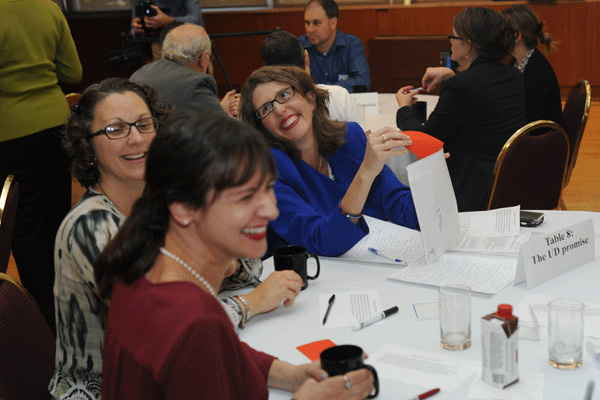Our moment in history
If the University of Dayton is to thrive in an era of increased competition for students, research funding and private support, it has to be agile.
That's one of the early overriding themes in draft reports from five working groups charged with developing an aspirational strategic vision that peers 20 years into the future. More than 2,000 people provided input, and another 1,700 participated in a Facebook Live event.
"We heard a lot of discussion about the need for greater institutional agility — from flexible workloads to flexible learning spaces," Provost Paul Benson told a standing-room-only classroom filled with faculty and staff interested in learning the high-level recommendations of the strategic visioning committee's working groups. For the full reports and a short overview, click here.
 Both Benson and MPA Director Michelle Pautz, co-leaders of the yearlong visioning exercise, cautioned those gathered at the Jan. 6 drop-in session that the recommendations are preliminary and input is still being sought through a variety of channels, including emails, surveys, alumni gatherings and a board of trustees' retreat. Another drop-in session is slated for 3-4 p.m., Thursday, Jan. 12, in Kennedy Union 310 for the campus community to hear an update and offer input.
Both Benson and MPA Director Michelle Pautz, co-leaders of the yearlong visioning exercise, cautioned those gathered at the Jan. 6 drop-in session that the recommendations are preliminary and input is still being sought through a variety of channels, including emails, surveys, alumni gatherings and a board of trustees' retreat. Another drop-in session is slated for 3-4 p.m., Thursday, Jan. 12, in Kennedy Union 310 for the campus community to hear an update and offer input.
"This is just one snapshot in time," Benson said. "President (Eric) Spina is not looking for good things to do, great things to do or even important things to do. He's looking for ideas that will truly differentiate the University of Dayton, be genuinely innovative and will enable us to achieve national or international excellence. He wants to develop an aspirational vision that builds on our strengths and assets, reflects our mission and is bold."
A few of the emerging themes and recommendations, all still under active discussion and will be thinned, refined and strengthened in the next few months:
• Recognition as a global leader for the way social justice weaves throughout the campus culture, curriculum and lives of graduates.
• A deep commitment to inclusivity and access to education that is anchored in socio-economic diversity and will lead to broad representation among traditionally marginalized populations.
• A requirement that all undergraduates graduate with at least one experiential learning immersion that develops global and intercultural competencies and helps them discern their calling in life.
• An expansion of UD's footprint to other cities and the development of deeper, more visible and reciprocal partnerships in the Dayton region.
• Leadership in a small number of multi-disciplinary research domains from among such areas as sustainability, human rights, innovation and technology, human health and wellness, and Marian studies.
• Recognition as a model campus laboratory for sustainable practices, research and experiential learning.
Acknowledging that the working groups cannot accurately predict the way technology or other innovations will shape the culture and economy in two decades, Benson stressed the value of nimbleness in all areas — from curriculum and learning spaces to research and civic and global engagement.
"We don’t know where the jobs will be in 25 years," he said. "We need to give students a very broad and creative tool set. That's why institutional flexibility is so important."
Spina said he’s encouraged by the ideas shared during the strategic visioning process: “It is clear that the broad set of strategic visioning listening sessions and workshops this fall — conducted from Dayton to D.C. and from Los Angeles to New York City — have queued up a number intriguing possibilities. While there is more work to do to achieve the bold aspirational vision that is the objective, this foundational work clearly positions the University of Dayton for success.”